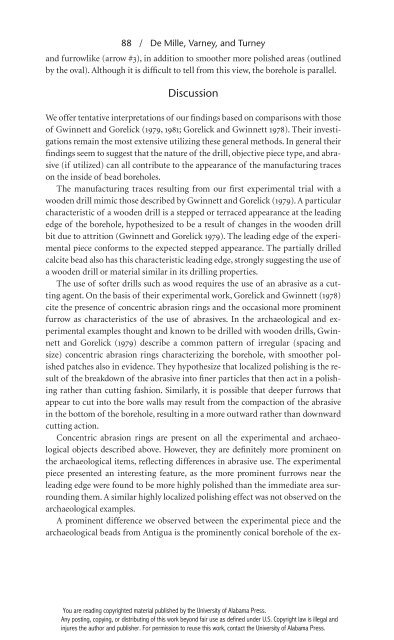Crossing the Borders: New Methods and Techniques in the Study of Archaeological Materials from the Caribbean
by Corrine L. Hoffman, et. al.
by Corrine L. Hoffman, et. al.
Create successful ePaper yourself
Turn your PDF publications into a flip-book with our unique Google optimized e-Paper software.
88 / De Mille, Varney, <strong>and</strong> Turney<br />
<strong>and</strong> furrowlike (arrow #3), <strong>in</strong> addition to smoo<strong>the</strong>r more polished areas (outl<strong>in</strong>ed<br />
by <strong>the</strong> oval). Although it is difficult to tell <strong>from</strong> this view, <strong>the</strong> borehole is parallel.<br />
Discussion<br />
We <strong>of</strong>fer tentative <strong>in</strong>terpretations <strong>of</strong> our f<strong>in</strong>d<strong>in</strong>gs based on comparisons with those<br />
<strong>of</strong> Gw<strong>in</strong>nett <strong>and</strong> Gorelick (1979, 1981; Gorelick <strong>and</strong> Gw<strong>in</strong>nett 1978). Their <strong>in</strong>vestigations<br />
rema<strong>in</strong> <strong>the</strong> most extensive utiliz<strong>in</strong>g <strong>the</strong>se general methods. In general <strong>the</strong>ir<br />
f<strong>in</strong>d<strong>in</strong>gs seem to suggest that <strong>the</strong> nature <strong>of</strong> <strong>the</strong> drill, objective piece type, <strong>and</strong> abrasive<br />
(if utilized) can all contribute to <strong>the</strong> appearance <strong>of</strong> <strong>the</strong> manufactur<strong>in</strong>g traces<br />
on <strong>the</strong> <strong>in</strong>side <strong>of</strong> bead boreholes.<br />
The manufactur<strong>in</strong>g traces result<strong>in</strong>g <strong>from</strong> our first experimental trial with a<br />
wooden drill mimic those described by Gw<strong>in</strong>nett <strong>and</strong> Gorelick (1979). A particular<br />
characteristic <strong>of</strong> a wooden drill is a stepped or terraced appearance at <strong>the</strong> lead<strong>in</strong>g<br />
edge <strong>of</strong> <strong>the</strong> borehole, hypo<strong>the</strong>sized to be a result <strong>of</strong> changes <strong>in</strong> <strong>the</strong> wooden drill<br />
bit due to attrition (Gw<strong>in</strong>nett <strong>and</strong> Gorelick 1979). The lead<strong>in</strong>g edge <strong>of</strong> <strong>the</strong> experimental<br />
piece conforms to <strong>the</strong> expected stepped appearance. The partially drilled<br />
calcite bead also has this characteristic lead<strong>in</strong>g edge, strongly suggest<strong>in</strong>g <strong>the</strong> use <strong>of</strong><br />
a wooden drill or material similar <strong>in</strong> its drill<strong>in</strong>g properties.<br />
The use <strong>of</strong> s<strong>of</strong>ter drills such as wood requires <strong>the</strong> use <strong>of</strong> an abrasive as a cutt<strong>in</strong>g<br />
agent. On <strong>the</strong> basis <strong>of</strong> <strong>the</strong>ir experimental work, Gorelick <strong>and</strong> Gw<strong>in</strong>nett (1978)<br />
cite <strong>the</strong> presence <strong>of</strong> concentric abrasion r<strong>in</strong>gs <strong>and</strong> <strong>the</strong> occasional more prom<strong>in</strong>ent<br />
furrow as characteristics <strong>of</strong> <strong>the</strong> use <strong>of</strong> abrasives. In <strong>the</strong> archaeological <strong>and</strong> experimental<br />
examples thought <strong>and</strong> known to be drilled with wooden drills, Gw<strong>in</strong>nett<br />
<strong>and</strong> Gorelick (1979) describe a common pattern <strong>of</strong> irregular (spac<strong>in</strong>g <strong>and</strong><br />
size) concentric abrasion r<strong>in</strong>gs characteriz<strong>in</strong>g <strong>the</strong> borehole, with smoo<strong>the</strong>r polished<br />
patches also <strong>in</strong> evidence. They hypo<strong>the</strong>size that localized polish<strong>in</strong>g is <strong>the</strong> result<br />
<strong>of</strong> <strong>the</strong> breakdown <strong>of</strong> <strong>the</strong> abrasive <strong>in</strong>to f<strong>in</strong>er particles that <strong>the</strong>n act <strong>in</strong> a polish<strong>in</strong>g<br />
ra<strong>the</strong>r than cutt<strong>in</strong>g fashion. Similarly, it is possible that deeper furrows that<br />
appear to cut <strong>in</strong>to <strong>the</strong> bore walls may result <strong>from</strong> <strong>the</strong> compaction <strong>of</strong> <strong>the</strong> abrasive<br />
<strong>in</strong> <strong>the</strong> bottom <strong>of</strong> <strong>the</strong> borehole, result<strong>in</strong>g <strong>in</strong> a more outward ra<strong>the</strong>r than downward<br />
cutt<strong>in</strong>g action.<br />
Concentric abrasion r<strong>in</strong>gs are present on all <strong>the</strong> experimental <strong>and</strong> archaeological<br />
objects described above. However, <strong>the</strong>y are def<strong>in</strong>itely more prom<strong>in</strong>ent on<br />
<strong>the</strong> archaeological items, reflect<strong>in</strong>g differences <strong>in</strong> abrasive use. The experimental<br />
piece presented an <strong>in</strong>terest<strong>in</strong>g feature, as <strong>the</strong> more prom<strong>in</strong>ent furrows near <strong>the</strong><br />
lead<strong>in</strong>g edge were found to be more highly polished than <strong>the</strong> immediate area surround<strong>in</strong>g<br />
<strong>the</strong>m. A similar highly localized polish<strong>in</strong>g effect was not observed on <strong>the</strong><br />
archaeological examples.<br />
A prom<strong>in</strong>ent difference we observed between <strong>the</strong> experimental piece <strong>and</strong> <strong>the</strong><br />
archaeological beads <strong>from</strong> Antigua is <strong>the</strong> prom<strong>in</strong>ently conical borehole <strong>of</strong> <strong>the</strong> ex-<br />
You are read<strong>in</strong>g copyrighted material published by <strong>the</strong> University <strong>of</strong> Alabama Press.<br />
Any post<strong>in</strong>g, copy<strong>in</strong>g, or distribut<strong>in</strong>g <strong>of</strong> this work beyond fair use as def<strong>in</strong>ed under U.S. Copyright law is illegal <strong>and</strong><br />
<strong>in</strong>jures <strong>the</strong> author <strong>and</strong> publisher. For permission to reuse this work, contact <strong>the</strong> University <strong>of</strong> Alabama Press.


















